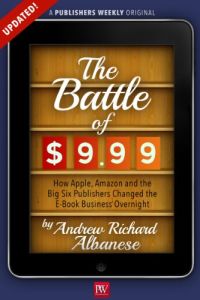Join getAbstract to access the summary!

Join getAbstract to access the summary!
Andrew Richard Albanese
The Battle of $9.99
How Apple, Amazon and the Big Six Publishers Changed the E-Book Business Overnight
PW, 2013
What's inside?
Journalist Andrew Richard Albanese takes readers behind the scenes of Amazon and Apple’s e-book war.
Recommendation
Veteran journalist Andrew Richard Albanese’s tale of corporate warfare in the e-book business reads like a gripping long-form article ready for your Kindle or iPad. At the onset of the e-book mass-market industry, Amazon’s $9.99 per-book pricing strategy came as an unwelcome surprise to publishers. When Apple wanted to enter the e-book market, publishers saw its arrival as a way to wrest back the pricing control they had ceded to Amazon. Their counterattack led to antitrust charges. The publishers settled, but the court found Apple guilty of price fixing. With clarity and directness, Albanese walks you through each step of Apple’s careful orchestration of a master plan that altered publishing’s prevailing business model. The sheer volume of filings and testimony provides Albanese enough paint to produce a revealing portrait of Apple’s decision-making system. Direct quotes from the principals and attention to detail lend credibility to the saga, yet the book falls short in one regard: Albanese’s sense of chronology is set too loosely, presumably for narrative purposes, so readers may sometimes find it hard to follow the sequence of events. getAbstract recommends this brief, illuminating report of savage corporate infighting and its unintended consequences to anyone interested in the evolving dynamics among content producers, publisher, gatekeepers and distributors, and to everyone who buys books.
Summary
About the Author
Andrew Richard Albanese is the features editor at Publishers Weekly. He writes on the publishing and information technology industries for numerous periodicals.

















Comment on this summary